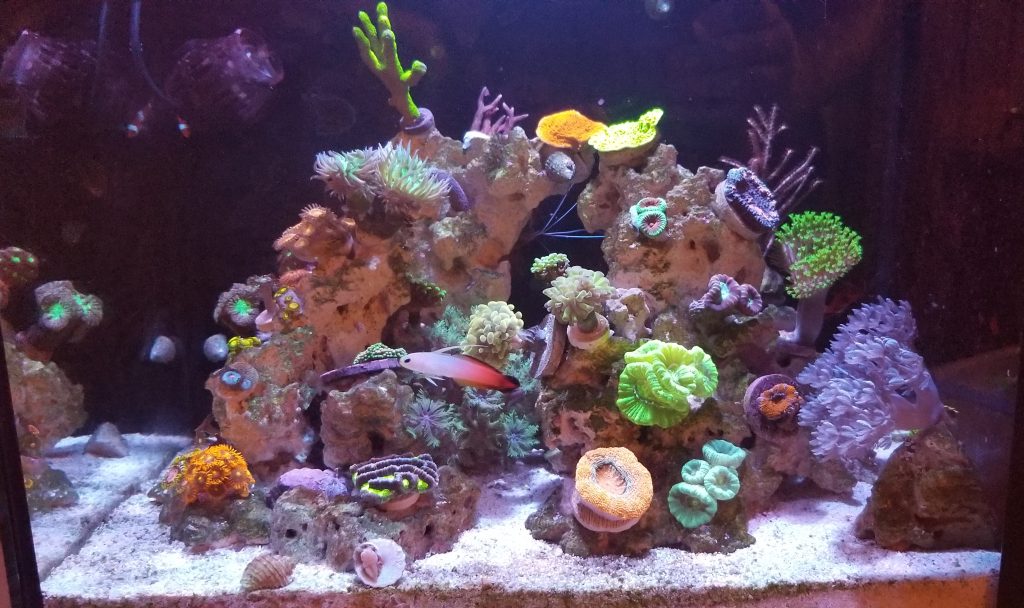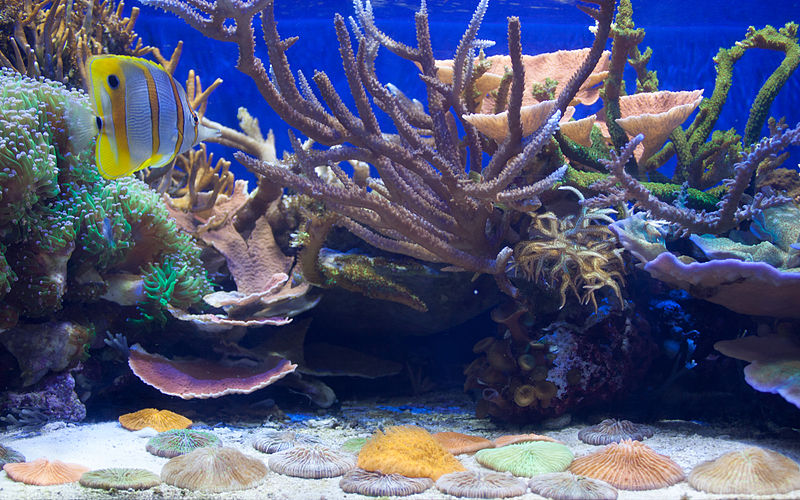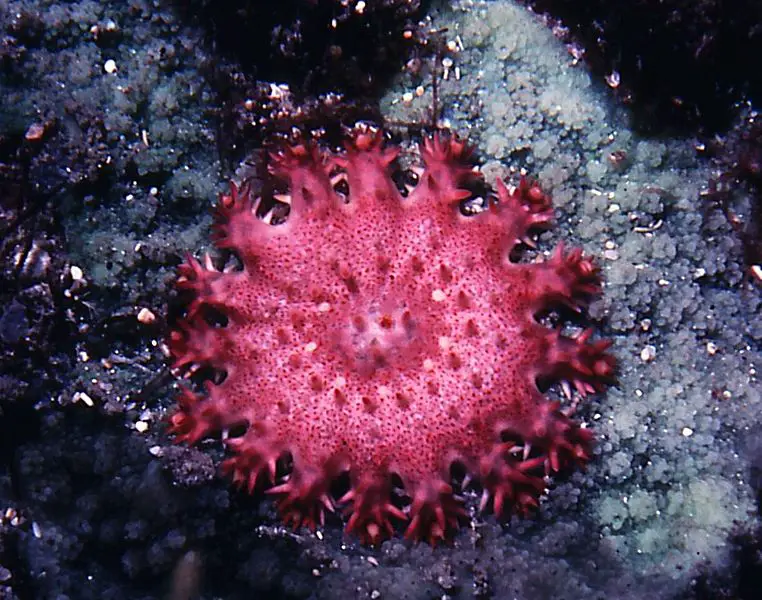What is the Ideal Tank Size for a Coral Reef Aquarium? Essential Factors to Consider
Coral reef aquariums are a mesmerizing addition to any home or office, providing an ecosystem for marine life and a visual treat for the viewers. Choosing the right tank size for a coral reef aquarium is crucial to maintaining the delicate balance that keeps corals and other marine species healthy and thriving. There are a few factors to consider when selecting the ideal size, such as the types of corals you want to house, the space available, and your budget.
For beginners, it’s essential to start with a tank large enough to sustain a stable environment for coral growth while allowing room for various fish and other invertebrates. Generally, a 40 to 75-gallon tank is considered a good size for newcomers to the coral reef world. Additionally, all-in-one aquariums are a popular choice, as they come with built-in equipment, making setup and maintenance more manageable.
When selecting the perfect reef tank size, consider aesthetics and the requirements of the aquatic species you plan to house. The larger the tank, the more stable the water parameters and temperature will be, creating an optimal environment for coral growth and overall health.
Determining the Ideal Tank Size
Space and Budget Considerations
When planning a coral reef aquarium, it’s essential to consider the space you have available and your budget. Tank size is directly related to the cost and maintenance required, with larger tanks typically being more expensive and requiring more upkeep. However, bigger tanks are often preferred in reef keeping because they provide better stability for delicate corals and marine life.
Consider the dimensions and weight of the aquarium, as well as the strength of the tank stand. It’s essential to ensure that the stand can support the filled aquarium’s weight and any additional equipment.
Some popular tank sizes for beginners include:
- 40-gallon breeder
- 60-gallon cube
- 93-gallon square
- 120-gallon rectangle
- 180-gallon rectangle
These tank sizes provide a good balance between space, budget, and the ability to house various corals and fish.

Fish Compatibility and Livestock
The choice of an ideal tank size also depends on the fish species you plan to keep. Some fish, such as tangs, require larger swimming spaces and may need at least six feet in their longest dimension. For example, a tank measuring 51x51x34 inches would provide six feet of room for a fully grown tang while maintaining proportions.
Selecting a larger tank size accommodates various fish species and provides more room for corals to thrive. Hardy corals that can tolerate various lighting conditions and water parameters are ideal for beginners.
The water volume of your aquarium is crucial for maintaining a stable environment for your corals and fish. A larger tank can accommodate more substantial fluctuations in water temperature, pH levels, and nutrient concentrations, making it easier to maintain a healthy ecosystem. Additionally, larger tanks provide more space for corals to grow, accommodating higher livestock densities and making for a more captivating display.
In conclusion, choosing an ideal tank size is essential to ensure a thriving coral reef aquarium. By considering factors such as space, budget, and compatibility of fish species and coral requirements, selecting a suitable tank size that meets your specific needs is possible.
Essential Equipment for Coral Reef Aquariums
Lighting Systems
A crucial aspect of maintaining a coral reef aquarium is proper lighting. Different types of corals require varying levels of light intensity and spectrum. Research the specific needs of the corals before selecting a suitable lighting system. Standard options include LED lights, metal halide lights, and T5 fluorescent lights. LED lights are popular due to their energy efficiency, customizable spectrum, and long lifespan.
Filtration and Water Flow
Saltwater aquariums require consistent water flow to appropriately distribute nutrients and waste. Adequate filtration helps maintain water quality and prevents the buildup of harmful substances. There are several filtration options available, including:
- Mechanical filtration: Uses foam, sponges, or filter socks to trap debris.
- Biological filtration: Contains beneficial bacteria that convert toxic substances into less harmful byproducts.
- Chemical filtration: Utilizes activated carbon or other media to remove contaminants and improve water clarity.
Powerheads and wave-making devices can be used to create water movement within the tank, simulating the natural environment of corals.
Heating and Cooling
Controlling the temperature is critical for the health of corals and other inhabitants of a saltwater aquarium. Therefore, it is essential to maintain a stable temperature range, typically around 75-80°F (24-27°C). Heaters increase the water temperature, while chillers or fans help cool it down when necessary. Regularly monitoring the temperature ensures water stability, contributing to a thriving coral reef aquarium.
Protein Skimming
A protein skimmer is an essential piece of equipment for maintaining water quality in a coral reef tank. It removes organic waste, such as uneaten food and fish waste, before it breaks down and causes poor water conditions. Protein skimmers are categorized as in-sump, hang-on-back, and external models, depending on the aquarium setup. An in-sump protein skimmer is usually the most suitable option for all-in-one aquariums with built-in filtration.
In conclusion, to set up a flourishing coral reef aquarium, it is crucial to have proper lighting, filtration and water flow, heating and cooling, and protein skimming equipment. Understanding the specific needs of the corals and other tank inhabitants will help guide the selection of the ideal equipment for a thriving saltwater ecosystem.
Water Parameters and Testing
Maintaining proper water parameters is crucial for a healthy coral reef aquarium. Understanding and monitoring the levels of various elements can help prevent issues such as algae blooms and disease, ensuring the well-being of the aquarium’s inhabitants.
Regular Water Changes
Performing regular water changes is essential to maintaining a stable environment in a coral reef aquarium. Removing a portion of the old water and replacing it with fresh saltwater helps maintain appropriate salinity, pH, and nutrient levels while reducing the buildup of unwanted substances, such as ammonia and nitrite.
- Aim to perform water changes every 1-2 weeks.
- Replace about 10-20% of the tank’s water at each change.
- Ensure that the new saltwater’s parameters match the existing aquarium water.
Testing Kits and Techniques
Monitoring water parameters is essential for identifying potential issues and stabilizing the aquarium environment. Utilize accurate and reliable test kits to measure various parameters, such as:
- Temperature: Maintaining a range of 75-80°F (23.5-26.5°C) is important for coral health.
- Salinity: Aim for 35ppt or 1.0264 specific gravity to mimic natural coral reef conditions.
- Alkalinity: Maintain an alkalinity range of 8-12 dKH to support coral growth.
- Calcium: Levels should be between 380-450 ppm to promote strong coral skeleton formation.
- Magnesium: Keep levels within 1200-1400 ppm for optimal coral health.
- Ammonia, nitrite, and nitrate: Test regularly to ensure levels stay within safe ranges.
Ensure your test kits are up-to-date and follow the manufacturer’s directions for accurate results. Regular testing can help you identify trends and make the necessary adjustments to maintain stability in the aquarium.
Maintaining Stability
Striving for stability in a coral reef aquarium is essential for the health and well-being of its inhabitants. Consistent water parameters foster a thriving ecosystem, contributing to vibrant coral growth and a happy and healthy aquatic environment. To maintain stability:
- To provide consistent water parameters, utilize high-quality reef aquarium products, such as salt mixes.
- Employ quarantine procedures when adding new inhabitants to the aquarium to minimize the risk of introducing pests or diseases.
- Promote adequate water flow throughout the tank to ensure optimal gas exchange, temperature regulation, and nutrient distribution.
Remember that fluctuations in key aquarium parameters can result in stress to your tank inhabitants, leading to algae blooms, illness, or even the loss of coral or fish. Therefore, diligently monitor, adjust, and maintain your water parameters with a holistic approach to ensure a thriving coral reef aquarium.
Coral Types and Care
When planning a coral reef aquarium, it is essential to understand the different types of corals and their specific care requirements. In this section, we will explore soft corals, large polyp stony (LPS) corals, small polyp stony (SPS) corals, and unique corals.
Soft Corals
Soft corals are invertebrates that lack a hard, stony skeleton. They are generally considered more beginner-friendly due to their hardiness and ease of care. Some popular examples include palythoa, zoanthids, mushroom corals, and colt coral. Soft corals typically thrive on live rock, providing shelter and structure for saltwater fish.

To maintain healthy soft corals, consider the following water parameters:
- Temperature: 72º – 76º Fahrenheit (~ 22 – 24º Celsius)
- Salinity: 30-35 ppt or Specific Gravity 1.023 – 1.026 sg
- Nitrate: < 20 ppm
- pH: between 7.8 and 8.2
- Phosphate: < .10 ppm
- Calcium: 420-440 ppm
- Alkalinity: between 8 and 9.5 dKH
Popular soft coral types include:
- Green Star Polyps
- Gorgonians
- Leathers
- Ricordea
Soft Coral Types, Care, And Guide
Large Polyp Stony Corals (LPS)
LPS corals are characterized by their larger polyps and a hard calcium carbonate skeleton. Reef builders favor them for their stunning colors and variety of shapes. LPS corals require moderate to high lighting and stable water parameters, making them slightly more challenging than soft corals but still suitable for beginner to intermediate aquarists.
Common LPS corals include:
- Bubble Coral (Physogyra spp.)
- Closed Brain Coral (Symphyllia spp.)
- Lobed Brain Coral (Lobophyllia spp.)
12 Corals to Consider for Your Reef Aquarium
Small Polyp Stony Corals (SPS)
SPS corals are notable for their small polyps and intricate skeletal structure. They typically require higher lighting and more substantial water flow, making them more suitable for experienced aquarists. SPS corals are ideal for creating a diverse and captivating reef landscape.
Some well-known SPS coral species are:
- Acropora
- Montipora
- Pocillopora
Aquarium corals: definitive reef tank guide
Unique Corals
Apart from the commonly categorized corals, some unique species provide distinct characteristics that can add visual interest and diversity to your reef tank. These corals include toadstools, a type of soft coral known for their mushroom-like appearance, and fox corals (Nemenzophyllia spp.), with their fan-like structure.
When choosing coral types for your aquarium, consider the specific care requirements, compatibility with other tank inhabitants, and the overall aesthetic of your desired reef tank landscape. This knowledge will enable you to create a thriving, visually stunning coral reef aquarium that is enjoyable to maintain and observe.
Tips for Beginners
When starting a coral reef aquarium, the ideal tank size should be between 20 and 75 gallons in volume, as it provides a good balance between ease of maintenance and enough space to accommodate various corals and invertebrates in a healthy environment. The 40-gallon breeder tank is especially popular among beginners.
Beginners should also choose between glass and acrylic aquariums. While both materials have advantages and disadvantages, the overall cost is a key consideration for many.
Sufficient water flow is essential for a thriving saltwater aquarium, with a recommended flow rate of at least 20 times the tank size, in gallons per hour (GPH). A 50-gallon aquarium would equate to a flow rate of 1,000 GPH.
A well-maintained reef tank requires the right balance of invertebrates, including zoanthus and gorgonian corals, along with other saltwater species. When selecting species, consider factors such as compatibility, growth rates, and lighting requirements.
Live rock is an essential component in reef aquariums, acting as both a natural biological filter and a structural base for corals and other invertebrates. When adding live rock to a tank, maintain a balance between various shapes and sizes to create a visually appealing and functional habitat.
In addition to having a well-designed reef tank, new aquarists should keep these tips in mind:
- Visit local fish stores regularly to stay informed about new arrivals, ask questions, and get valuable advice.
- Establish a weekly routine to check water parameters, clean the tank, and perform water changes.
- Keep a stocklist of all species in the aquarium, their care requirements and compatibility information to monitor potential conflicts and issues.
- If a sump is part of your reef tank setup, ensure it is properly maintained and functioning to support the overall health of the tank.
Finally, new coral reef aquarists should be patient and open to learning through trial and error, as establishing a successful saltwater aquarium can take some time. However, by doing so, beginners will build the necessary skills to cultivate a thriving and beautiful underwater world.
Advanced Considerations
Advanced Filtration and Equipment
When setting up a coral reef aquarium, one of the key factors to consider is the advanced filtration and equipment that will help maintain a healthy environment for your corals and fish. Using a sump as part of your filtration system allows you to manage the water quality better and provides space for additional equipment like protein skimmers, heaters, and reactors.
A protein skimmer is a crucial piece of equipment that helps remove organic waste and improves water quality. Additionally, consider using carbon and calcium carbonate media in your reef tank to help maintain optimal water conditions.
Ensure you have reliable test kits to measure critical parameters such as ammonia, calcium, alkalinity, and nitrate. Monitoring these parameters will help prevent algae blooms and other issues that can harm the tank’s inhabitants.
Quarantine Procedures
Quarantine procedures are a vital aspect of managing a coral reef aquarium. It is essential to quarantine new arrivals, such as fish, corals, or invertebrates, for at least two to four weeks before introducing them to the main tank. This practice helps prevent the spread of diseases, pests, and parasites. In addition, you can use a separate tank as a designated quarantine area, ensuring it is well-equipped with proper filtration and water parameters.
Consider researching and investing in dip treatments for corals, as they can help remove and prevent unwanted hitchhikers, such as flatworms and pests, from entering your main tank.
Species-Specific Requirements
Remember that different coral species have unique needs when planning your coral reef aquarium. For instance, mushrooms, small polyp stony (SPS), and large polyp stony (LPS) corals might require different lighting, flow, and positioning within the tank.
Make informed decisions about the fish species you intend to include in the aquarium. Some fish, such as tangs, have specific dietary and spatial requirements. Considering these requirements when setting up your tank will ensure a harmonious environment for both fish and corals.
Make use of available resources such as videos and articles to learn about the unique needs of different coral and fish species. This knowledge will help you create the best environment for your coral reef aquarium, resulting in a thriving, healthy ecosystem.



